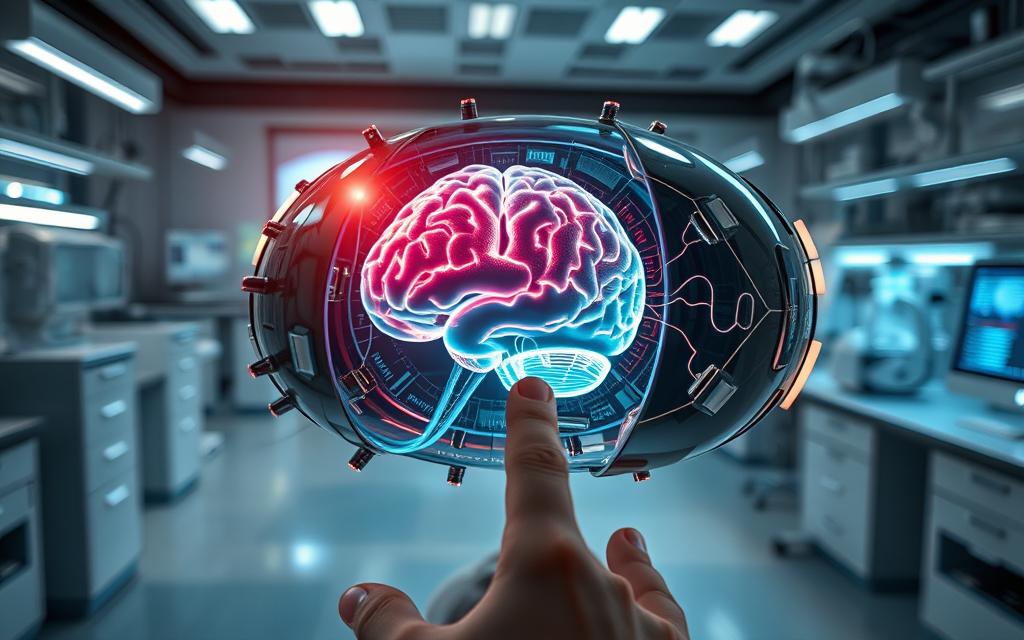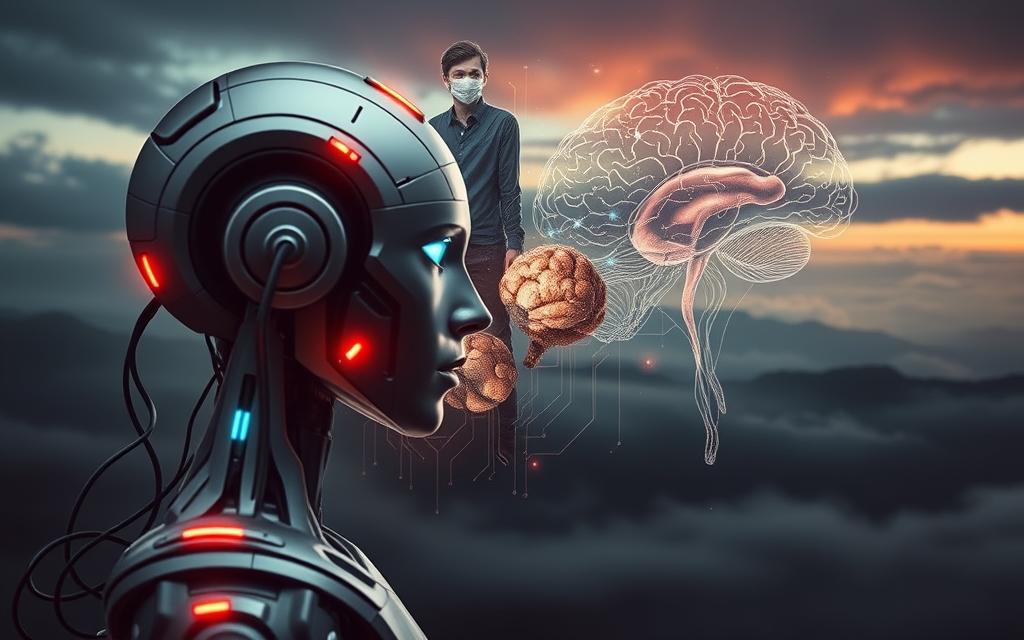Table of Contents
The idea oftechnologydeciphering human thoughts has long fascinated theworld. From sci-fi films to cutting-edge research, thequestionremains: how close are we to making this areality?
Modern systems like Alexa and Siri respond to voice commands, but true understanding is still limited. These tools rely on algorithms, not intuition. The gap between fiction and fact is wider than many realize.
Ethical concerns also arise. Emotion-detecting mirrors or smart fridges sound futuristic, but they raise privacy issues. Science is advancing, yet humans remain far more complex than any machine.
This article explores breakthroughs like brain-computer interfaces and affective computing. We’ll separate hype from genuine innovation—because knowing the truth matters.
The Turing Test: Can Machines Think Like Humans?
Decades after Turing’s proposal, machines still struggle with genuine thought. His 1950 imitation game—inspired by wartime codebreaking—asked whether artificial intelligence could deceive humans into believing it was one of them.
Alan Turing’s Legacy and the Imitation Game
The test was simple: a judge converses with hidden participants—one human, one machine. If the judge couldn’t tell them apart, the machine “passed.” Turing predicted that by 2000, computers would fool 30% of judges. Reality proved more complex.
Modern AI Chatbots: Passing or Cheating the Test?
Early attempts like ELIZA (1960s) used scripted responses to mimic therapists. Users often attributed human emotions to its simplistic text. Fast-forward to 2014, when Eugene Goostman “passed” by posing as a Ukrainian teen—using misspellings and cultural excuses.
“AI today excels at deception, not understanding.”
Google Duplex (2018) blurred lines further, booking appointments with natural pauses. Yet critics argue such feats rely on narrow data, not true cognition.
| Chatbot | Tactic | Limitation |
|---|---|---|
| ELIZA | Scripted reflections | No contextual awareness |
| Eugene Goostman | Cultural persona | Exploited judge biases |
| Google Duplex | Voice realism | Task-specific, no reasoning |
The problem remains: machines simulate intelligence without grasping meaning. Until they solve novel questions beyond pre-programmed rules, the Turing Test’s reality stays out of reach.
Brain-Computer Interfaces: Decoding Thoughts with Technology
Imagine typing words just by thinking—this is no longer science fiction. Brain-computer interfaces (BCIs) now translate neural activity into actions, blurring lines between mind and machine. These systems decode electrical signals from the body, offering hope for paralysis patients and amputees alike.

How Neurons and Electrodes Translate Thoughts
Neurons communicate via chemical synapses, firing electrical spikes called action potentials. Scientists implant electrodes in the premotor cortex to capture these signals. In groundbreaking research, paralyzed participants “typed” by imagining handwriting—their thoughts converted to text at 90 characters per minute.
Neuroprosthetics: Restoring Movement Through Mind Control
Advanced robotic limbs now replicate natural movement. One patient played piano using a neuroprosthetic hand, her intentions guiding each note. Bioelectronic medicine takes this further, stimulating nerves to treat conditions like rheumatoid arthritis—potentially replacing immunosuppressants.
“BCIs don’t read minds; they interpret motor intent. The brain’s plasticity adapts to these tools like a new limb.”
Unlike artificial intelligence, which simulates abstract thinking, BCIs address physical needs. They restore lost functions but lack true comprehension. The differences highlight how far we are from machines that genuinely “understand.”
Can a Computer Sense One’s Thinking? The Current State of Tech
Facial recognition systems claim to read feelings—but how accurate are they? Modern tools analyze micro-expressions, yet cultural biases and masked emotions challenge their precision. The gap between detecting smiles and understanding intent remains wide.
Affective Computing: Reading Emotions via Facial Recognition
MIT’s Affectiva database maps seven core emotions across 4 million videos. Its algorithms track eyebrow raises or lip twitches, labeling them as joy or anger. However, studies reveal flaws:
- Collectivist societies (e.g., Japan) often mask frustration, while individualist cultures (e.g., U.S.) display it openly.
- North Carolina State’s 2012 software misread boredom as focus in 30% of students.
“Affective tools excel at spotting smiles, not sarcasm. A grin in Tokyo might mean politeness, not happiness.”
Voice and Biometric Analysis: Beyond Facial Expressions
Creative Virtual’s customer-service bots detect frustration through vocal pitch spikes. Combined with heart-rate data, these systems claim 85% accuracy. Yet, voice language varies by age and dialect—Southern U.S. drawls are mislabeled as disinterest.
| Tool | Method | Limitation |
|---|---|---|
| Affectiva | Facial coding | Fails with neutral expressions |
| Creative Virtual | Voice cadence | Ignores cultural speech rhythms |
| BioSense | Heart-rate spikes | Confuses stress with excitement |
Real-world uses—like tutoring feedback or mental health monitoring—show promise. But until technology accounts for human complexity, it won’t truly sense thought.
Cultural and Ethical Challenges in Mind-Reading Tech
A laugh in London might be a frown in Mumbai—tech struggles to keep up. Emotion-detecting tools face cultural blind spots, while privacy debates question who should access neural data. The line between innovation and intrusion grows thinner.

Differences in Emotional Expression Across Demographics
Affectiva’s studies reveal stark contrasts. Japanese participants often masked frustration during comedy shows, while Americans expressed it openly. Age adds another layer: seniors smiled 40% less at slapstick humor than Gen Z.
These differences challenge algorithms trained on narrow datasets. MIT’s tools misread neutral expressions as boredom in 30% of cases. “Bias creeps in when training samples lack diversity,” notes Dr. el Kaliouby.
- Primetime comedy evoked 70% laughter in Brazil but only 45% in Germany.
- IBM Watson’s tone analysis confused Southern U.S. politeness with disinterest.
Privacy Concerns and the “Big Brother” Dilemma
Employers already monitor keystrokes—could brainwaves be next? The EU’s GDPR requires explicit consent for emotion systems, but loopholes exist. Ads exploiting mood data or insurers pricing policies by stress levels loom as risks.
“Decoding neural signals risks reducing minds to datasets. Mental privacy must be non-negotiable.”
Kurzweil’s 2029 predictions clash with reality. Current tools like Arria detect sarcasm in text but fail with nuanced dialects. Until tech respects cultural ways, the problem of misread emotions will persist.
From Sci-Fi to Reality: How Close Are We?
Hollywood paints AI as soulful companions, but real-world tech tells a different story. Films like Her depict machines with human-like intelligence, while tools like LaMDA generate poetic descriptions—yet lack true understanding. The divide between imagination and innovation remains vast.

Comparing Fictional Portrayals to Real-World Applications
LaMDA’s eloquent “smell of old books” response dazzled users, but it’s algorithmic mimicry. Unlike Her’s Samantha, it can’t contextualize emotions or form memories. These systems excel at pattern recognition, not genuine creativity.
Neuroscience highlights the challenge. The human brain contains 86 billion neurons—more than Earth’s population. Current machines process data faster but lack biological nuance. One MIT study showed AI misreads sarcasm 40% of the time.
The Limits of Neural Networks and AI Understanding
Large language models (LLMs) operate like supercharged auto-complete. They predict words but don’t grasp meaning. A therapist bot might suggest coping strategies, yet miss subtle cries for help.
“AI mirrors language without lived experience. It’s a dictionary, not a mind.”
Hybrid systems offer promise. Autism therapy apps combine AI analysis with human oversight, blending technology and empathy. For now, the future lies in partnership—not replacement.
Conclusion: The Fine Line Between Imagination and Innovation
The gap between human cognition and artificial systems remains vast. Turing reshaped how we define intelligence, yet debates persist—machines simulate, but don’t comprehend.
BCIs transform lives, restoring movement for paralyzed patients. Meanwhile, emotion-detecting technology risks eroding privacy. Ethical frameworks must evolve alongside innovation.
Progress demands balance. Bias audits and proactive oversight ensure tools serve humans, not exploit them. The future hinges on choices: Will we code empathy or control?
In this reality, collaboration trumps replacement. Machines augment, but never replace, the depth of human thought.
FAQ
Can machines truly understand human thoughts?
Modern technology can interpret patterns in data, but true comprehension remains limited. Artificial intelligence relies on algorithms, not consciousness.
What is the Turing Test, and do AI chatbots pass it?
The Turing Test evaluates if a system can mimic human responses. While some chatbots simulate conversation, they lack genuine intelligence.
How do brain-computer interfaces decode thoughts?
Neuroprosthetics use electrodes to translate neural signals into commands. This technology helps restore movement but doesn’t read abstract thinking.
Can software detect emotions accurately?
Affective computing analyzes facial expressions, voice tones, and biometrics. However, cultural differences and individual quirks affect accuracy.
What ethical issues surround mind-reading tech?
Privacy risks, biased algorithms, and misuse of data raise concerns. Regulations must balance innovation with human rights.
How close are we to sci-fi-level mind-reading?
Research advances in neural networks show promise, but replicating human cognition remains distant. Science still grapples with the complexity of the mind.









